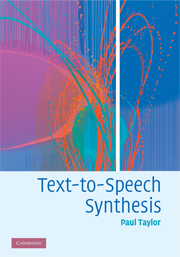Book contents
- Frontmatter
- Contents
- Foreword
- Preface
- 1 Introduction
- 2 Communication and language
- 3 The text-to-speech problem
- 4 Text segmentation and organisation
- 5 Text decoding: finding the words from the text
- 6 Prosody prediction from text
- 7 Phonetics and phonology
- 8 Pronunciation
- 9 Synthesis of prosody
- 10 Signals and filters
- 11 Acoustic models of speech production
- 12 Analysis of speech signals
- 13 Synthesis techniques based on vocal-tract models
- 14 Synthesis by concatenation and signal-processing modification
- 15 Hidden-Markov-model synthesis
- 16 Unit-selection synthesis
- 17 Further issues
- 18 Conclusion
- Appendix A Probability
- Appendix B Phone definitions
- References
- Index
7 - Phonetics and phonology
Published online by Cambridge University Press: 25 January 2011
- Frontmatter
- Contents
- Foreword
- Preface
- 1 Introduction
- 2 Communication and language
- 3 The text-to-speech problem
- 4 Text segmentation and organisation
- 5 Text decoding: finding the words from the text
- 6 Prosody prediction from text
- 7 Phonetics and phonology
- 8 Pronunciation
- 9 Synthesis of prosody
- 10 Signals and filters
- 11 Acoustic models of speech production
- 12 Analysis of speech signals
- 13 Synthesis techniques based on vocal-tract models
- 14 Synthesis by concatenation and signal-processing modification
- 15 Hidden-Markov-model synthesis
- 16 Unit-selection synthesis
- 17 Further issues
- 18 Conclusion
- Appendix A Probability
- Appendix B Phone definitions
- References
- Index
Summary
This chapter gives an outline of the related fields of phonetics and phonology. A good knowledge of these subjects is essential in speech synthesis because they help bridge the gap between the discrete, linguistic, word-based message and the continuous speech signal. More-traditional synthesis techniques relied heavily on phonetic and phonological knowledge, and often implemented theories and modules directly from these fields. Even in the more-modern heavily data-driven synthesis systems, we still find that phonetics and phonology have a vital role to play in determining how best to implement representations and algorithms.
Articulatory phonetics and speech production
The topic of speech production examines the processes by which humans convert linguistic messages into speech. The converse process, whereby humans determine the message from the speech, is called speech perception. Together these form the backbone of the field know as phonetics.
Regarding speech production, we have what we can describe as a complete but approximate model of this process. That is, in general we know how people use their articulators to produce the various sounds of speech. We emphasise, however, that our knowledge is very approximate; no model as yet can predict with any degree of accuracy how a speech waveform from a particular speaker would look like given some pronunciation input.
- Type
- Chapter
- Information
- Text-to-Speech Synthesis , pp. 146 - 191Publisher: Cambridge University PressPrint publication year: 2009



